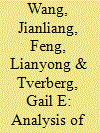|
|
|
Sort Order |
|
|
|
Items / Page
|
|
|
|
|
|
|
| Srl | Item |
| 1 |
ID:
121389


|
|
|
|
|
| Publication |
2013.
|
| Summary/Abstract |
Many people believe that China's economic growth can continue almost indefinitely. For a manufacturing-based economy such as China's to continue to grow, it needs an adequate supply of inexpensive energy. To date, this energy growth has primarily come from coal, but China's indigenous coal supplies are now falling short of the amount needed to support this growth. In this situation, the status of China's future coal supply will be very important for China's future economic development. Our analysis shows that China's ultimate recoverable coal reserves equal 223.6×109 MT, and its production will peak between 2025 and 2030, with peak production of approximately 3.9×109 MT. The extent to which China can import coal in the future is uncertain. With rising coal demand, this combination is likely to create a significant challenge to China's future economic development.
|
|
|
|
|
|
|
|
|
|
|
|
|
|
|
|
| 2 |
ID:
119846


|
|
|
|
|
| Publication |
2013.
|
| Summary/Abstract |
In order to achieve energy consumption targets, and subsequently reduce carbon emissions, China is working on energy strategies and policies aimed at actively increasing the consumption of natural gas-the lowest carbon energy of the fossil fuels, and to enhance the proportion of gas in total primary energy consumption. To do this, it is a necessary prerequisite that China must have access to adequate gas resources and production to meet demand. This paper shows that the availability of domestic gas resources are overestimated by China's authorities due to differences in classification and definitions of gas resources/reserves between China and those accepted internationally. Based on official gas resource figures, China's gas production remains low with respect to the projected demand, and will only be 164.6 bcm in 2020, far lower than the 375 bcm of forecast demand. The gap between gas production and demand will reach 210.4 bcm by 2020. Existing plans for the importation of gas and the development of unconventional gas will not close this gap in the next 10 years, and this situation will therefore present a severe challenge to China's gas security, achievement of targets in improving energy consumption structure and reducing carbon emissions.
|
|
|
|
|
|
|
|
|
|
|
|
|
|
|
|
| 3 |
ID:
110704


|
|
|
|
|
| Publication |
2011.
|
| Summary/Abstract |
This paper introduces two typical multicyclic models: the Hubbert model and the Generalized Weng model. The model-solving process of the two is expounded, and it provides the basis for an empirical analysis of the world's conventional oil production. The results for both show that the world's conventional oil (crude+NGLs) production will reach its peak in 2011 with a production of 30 billion barrels (Gb). In addition, the forecasting effects of these two models, given the same URR are compared, and the intrinsic characteristics of these two models are analyzed. This demonstrates that for specific criteria the multicyclic Generalized Weng model is an improvement on the multicyclic Hubbert model. Finally, based upon the resultant forecast for the world's conventional oil, some suggestions are proposed for China's policy makers.
|
|
|
|
|
|
|
|
|
|
|
|
|
|
|
|
| 4 |
ID:
088210


|
|
|
|
|
| Publication |
2009.
|
| Summary/Abstract |
Peak oil research and the Association for the Study of Peak Oil and Gas (ASPO) have contributed a great deal to improve people's recognition of peak oil. Although peak oil is becoming a part of public recognition, it is still hard to say whether peak oil discussion will develop into a theory such as "peakoilism". On one hand, there are still some difficult problems in peak oil research. On the other hand, the peakoilers have the potential for scientific research and have their allies: the climate change researchers and the new energy advocates. Oil is a limited, non-renewable resource, and an oil peak is inevitable. Peak oil theory is a kind of development theory rather than a crisis theory, which promotes reasonable utilization of the limited oil resources, promotes conservation, and encourages the development of renewable energy.
|
|
|
|
|
|
|
|
|
|
|
|
|
|
|
|
|
|
|
|
|